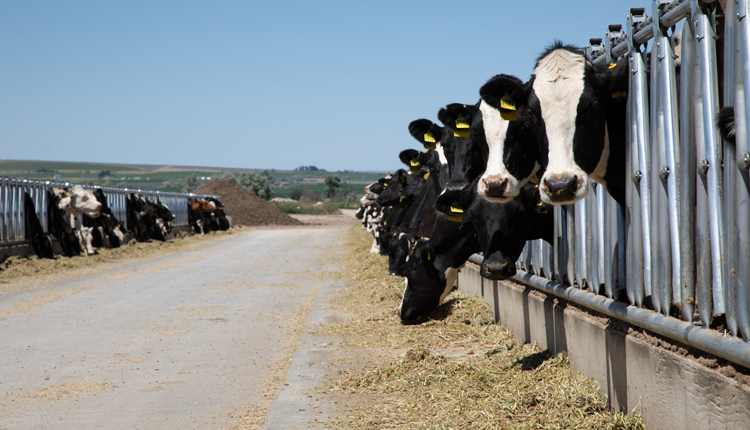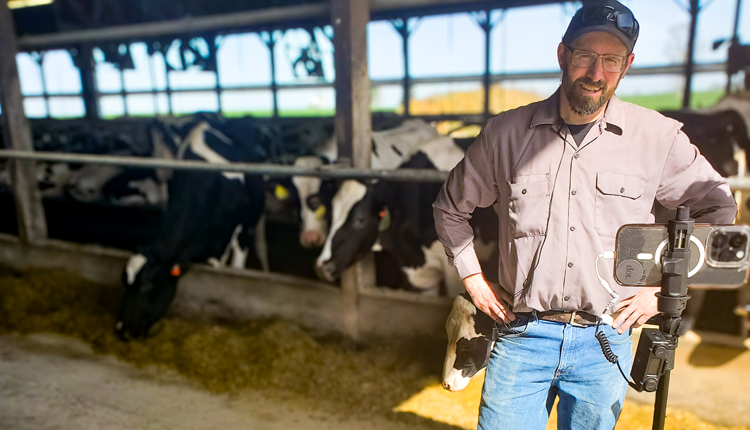Transition cows are much like a puzzle that is missing a few pieces; we're still working to develop the full picture. Feeding strategies are one piece of the transition cow puzzle that has evolved through years of trial and error.
"High forage diets for close-up dairy cows are gaining popularity and are perceived to provide health and production advantages," noted Julie Huzzey, in a poster presentation at the Joint Annual Meeting of the American Dairy Science Association and the American Society of Animal Scientists.
After calving, cows typically transition to a high-energy diet. While at the University of British Columbia, Huzzey and colleagues compared the effect of keeping cows on a high-forage diet for three weeks after calving versus switching cows to a conventional high-energy diet.
All cows (68) were fed the same dry cow TMR (total mixed ration) for the two weeks prior to calving. After parturition, 34 animals were fed a control diet, while the remainder were fed a TMR that contained 4.3 percent wheat straw on a dry matter basis.
Individual feed intakes were measured with an electronic feeding system and rumination time was recorded with an HR-Tag. Blood was tested twice weekly for BHBA (beta-hydroxybutyric acid) and aided in subclinical ketosis diagnosis.
As can be expected, prepartum-feeding behaviors did not differ between the treatment groups. After calving, a slower feeding rate, reduced intake and longer feeding and rumination times were seen. "Forage fiber increases rumen fill, reduces passage time and extends chewing time," noted Huzzy, now at Cal Poly. These characteristics of higher-forage diets explain the above changes in feeding behavior.
Cows fed the straw TMR had the highest BHBA concentrations during the last two weeks of the treatment period. This was likely due to their lower dry matter intakes on a less energy dense diet. These cows were also five times more likely to develop subclinical ketosis than cows fed the control diet.
Milk yield was about 6 pounds per day lower when cows were fed the TMR that contained straw after calving compared to the control diet.
Overall, maintaining cows on a high-forage diet for 21-days after calving can have detrimental effects on behavior, health and performance, concluded Huzzy. Twenty-one days on this type of high-forage diet (added wheat straw) is not appropriate. While there may be some short-term benefits of added forage after calving, these get overshadowed by the lack of energy if it is fed too long. More work is needed to understand the impact of high forage diets postpartum.
 Amanda Smith was an associate editor and is an animal science graduate of Cornell University. Smith covers feeding, milk quality and heads up the World Dairy Expo Supplement. She grew up on a Medina, N.Y., dairy, and interned at a 1,700-cow western New York dairy, a large New York calf and heifer farm, and studied in New Zealand for one semester.
Amanda Smith was an associate editor and is an animal science graduate of Cornell University. Smith covers feeding, milk quality and heads up the World Dairy Expo Supplement. She grew up on a Medina, N.Y., dairy, and interned at a 1,700-cow western New York dairy, a large New York calf and heifer farm, and studied in New Zealand for one semester.
"High forage diets for close-up dairy cows are gaining popularity and are perceived to provide health and production advantages," noted Julie Huzzey, in a poster presentation at the Joint Annual Meeting of the American Dairy Science Association and the American Society of Animal Scientists.
After calving, cows typically transition to a high-energy diet. While at the University of British Columbia, Huzzey and colleagues compared the effect of keeping cows on a high-forage diet for three weeks after calving versus switching cows to a conventional high-energy diet.
All cows (68) were fed the same dry cow TMR (total mixed ration) for the two weeks prior to calving. After parturition, 34 animals were fed a control diet, while the remainder were fed a TMR that contained 4.3 percent wheat straw on a dry matter basis.
Individual feed intakes were measured with an electronic feeding system and rumination time was recorded with an HR-Tag. Blood was tested twice weekly for BHBA (beta-hydroxybutyric acid) and aided in subclinical ketosis diagnosis.
As can be expected, prepartum-feeding behaviors did not differ between the treatment groups. After calving, a slower feeding rate, reduced intake and longer feeding and rumination times were seen. "Forage fiber increases rumen fill, reduces passage time and extends chewing time," noted Huzzy, now at Cal Poly. These characteristics of higher-forage diets explain the above changes in feeding behavior.
Cows fed the straw TMR had the highest BHBA concentrations during the last two weeks of the treatment period. This was likely due to their lower dry matter intakes on a less energy dense diet. These cows were also five times more likely to develop subclinical ketosis than cows fed the control diet.
Milk yield was about 6 pounds per day lower when cows were fed the TMR that contained straw after calving compared to the control diet.
Overall, maintaining cows on a high-forage diet for 21-days after calving can have detrimental effects on behavior, health and performance, concluded Huzzy. Twenty-one days on this type of high-forage diet (added wheat straw) is not appropriate. While there may be some short-term benefits of added forage after calving, these get overshadowed by the lack of energy if it is fed too long. More work is needed to understand the impact of high forage diets postpartum.
 Amanda Smith was an associate editor and is an animal science graduate of Cornell University. Smith covers feeding, milk quality and heads up the World Dairy Expo Supplement. She grew up on a Medina, N.Y., dairy, and interned at a 1,700-cow western New York dairy, a large New York calf and heifer farm, and studied in New Zealand for one semester.
Amanda Smith was an associate editor and is an animal science graduate of Cornell University. Smith covers feeding, milk quality and heads up the World Dairy Expo Supplement. She grew up on a Medina, N.Y., dairy, and interned at a 1,700-cow western New York dairy, a large New York calf and heifer farm, and studied in New Zealand for one semester.










